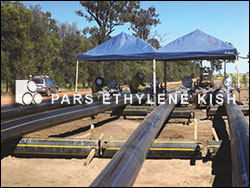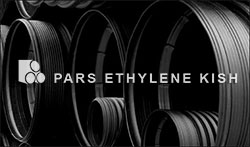|

PE Pipe FAQ
• What is HDPE pipe?
HDPE stands for high density polyethylene (many times just referred to as PE), and is made from ethylene, which can be derived from either crude oil or natural gas. PE Pipe is extremely strong, durable, flexible, corrosion free and chemical resistant.
• What makes PE unique?
PE pipe is joined together through a unique heat fusion process that creates a seal resulting in a strong leak-free system.
• What are the advantages of PE pipe for municipal water and sewer use?
Other types of plastic and iron pipes require joints to turn and link the pipe.  These joints tend to lose water as it flows through the pipe. PE pipe is fused together so that the links are equally strong or stronger than the rest of the pipe, meaning that it holds water much better than other types of pipe. These joints tend to lose water as it flows through the pipe. PE pipe is fused together so that the links are equally strong or stronger than the rest of the pipe, meaning that it holds water much better than other types of pipe.
• Why is a leak-free system such a big deal?
Water is a precious resource. Conservation has become a top priority for many cities today. It's estimated that more than 2.5 billion gallons of drinking water are lost every day in the United States underground water system. That means that as much as 22 percent of the total water in our underground pipes has leaked out and is wasted. Municipalities and taxpayers can no longer afford this loss.
• What can PE pipe carry?
PE pipe transports potable water, wastewater, chemicals, and compressed gases.
• What other materials are used for potable water and sewer pipes?
There are basically two: Polyvinyl chloride (PVC), which is plastic and ductile iron, which is metal and includes iron, brass, and copper.
• Why is PE pipe better than metal pipe?
Unlike other materials, PE pipe does not corrode over time and is not susceptible to chemical damage. It is also much more flexible and can move with different soil conditions and ground movement. Because it is light weight, it is easier to handle, transport, and fix, which in turn reduces costs.
• How does the leakage from PE pipe compare to metal and PVC pipe?
PE pipe is joined by a heat fusion process that forms strong and leak-free pipe. The “allowable water leakage” rate of PE pipe is zero. PVC and ductile iron installations have “allowable leakage rates” as high as 10 percent.
• Are there certain soil requirements for PE pipe?
No. PE pipe is known for its flexibility, toughness and chemical resistance. PE pipe can withstand great pressure changes due to its outstanding ductility and toughness. These performance characteristics make PE pipe an excellent choice for dynamic soils and earthquake prone areas that require a strong, long-lasting and corrosion-resistant pipe that is also flexible enough to be installed and assembled in harsh and challenging environments.
• Can PE pipe be installed without digging a trench?
YES. PE pipe can be installed with pipe bursting, sliplining, or horizontal directional drilling (HDD) techniques, all of which are trenchless. These types of installations significantly reduce the overall costs since highways and other immovable structures do not have to be disrupted. 
o Pipe bursting: An expanding device called an expander head is sent into the defective pipeline. It travels through the pipeline toward the other end and breaks the pipe into many small pieces, pushing the pieces into the surrounding soil. New pipe is attached to the back of the expander head, replacing the old pipe immediately. Watch animation.
o Sliplining: A cable is inserted through the defective pipeline and then attached to the front of the new pipe. The new liner pipe is then pulled into the existing pipe, and the new liner pipe reconnected to the system. The new pipe must be smaller in diameter than the old pipe.
o Directional Drilling: This technique is used to install brand new pipe without digging up the ground and is especially effective around roads and bodies of water. It is a three-stage process. Stage one involves drilling a hole along the designated path. Stage two involves passing a device called a “reamer” through the hole to enlarge it. Stage three involves sending the pipe through the hole and connecting it to the system. The entire operation is run from above ground using a control system that guides the drilling.
• How does the overall cost of PE compare in price with other materials?
Underground water pipes are a major long term (50-100 years) investment. In addition to comparing the initial purchase price, the long term maintenance costs and overall life-cycle costs should be carefully evaluated. According to the Federal Highway Administration, utilities spend $36 billion annually on corrosion protection of pipes. Because PE pipe does not corrode and does not leak at the joints, constant repair of aging metal pipes or leaking at the joints with all other pipes is no longer an issue. Initial cost savings are also realized with the opportunity for a trenchless installation. Compared to PVC and ductile iron, PE has the lowest life-cycle costs due to lower installation costs, lower repair rates, less water loss and lower energy costs.
• How do the failure rates of PE pipes compare to those of ductile iron and PVC?
In a nine-year span between 1995 and 2003 in Europe, PE pipes averaged around four failures per 100km per year, while ductile iron and PVC averaged around eight and nine failures per 100km per year, respectively.
• Is the demand for PE pipe going anywhere?
Yes. Up! According to Global Industry Analysts, Inc. the compounded annual growth rate (CAGR) for PE pipe is an astounding 6.13 percent through 2010, while PVC is falling behind with only a 3.84 percent growth rate.
• Why is PE pipe better?
Besides being leak free, PE pipe is environmentally friendly and is less intrusive to communities when it is installed. Instead of ripping up roads, sidewalks and habitats, municipalities can choose to use a trenchless installation technique which results in less disruption to “Main Street” or the environment.
Case Studies...
• PE Industrial`s Experiences | Case Study »
• HDPE Performs best in Bow »
• Large scale pipe-bursting used in Windsor, Ontario »
• HDPE Pipe & HDD Solve Sewage Back-up Problem »
• Texas builds emergency HDPE water reuse pipeline »
• Use the PE 100 Supply pipes for the new construction of the BMW car factory in Leipzig »
• Hydroelectric Power Plant’s Steel Cooling Water Piping System Replaced with HDPE Pipe »
Valve | PEX pipe | Push fit system | Plastic pipe | HDPE pipe | Water pipe
UPVC pipe | Spiral pipe | Gas pipe | Underground pipe | Polyethylene pipe fitting | Pipe installation
|